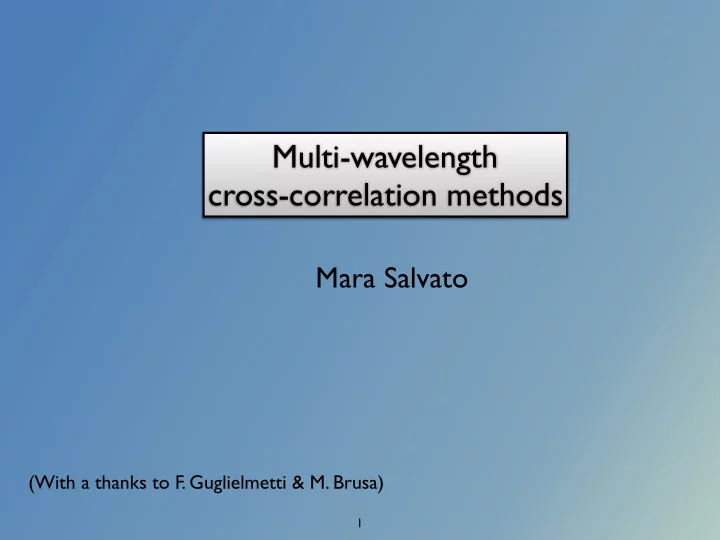

Multi-wavelength cross-correlation methods Mara Salvato (With a thanks to F. Guglielmetti & M. Brusa) 1
Structure of the talk: • Why multi wavelength cross-matches are important • All what can go wrong • Methods descriptions • Possible new solutions to some of the problems • Summary ToGo 2
The association is ALL! combining photometry from different sources produces the wrong SED For Xray counterparts: Applying priors to the wrong source produces wrong photometric redshift Salvato+09,11, Fotopoulou+12, Hsu+14, Ananna+16, Marchesi+16 3
Coordinates are the first source of problem. Hsu+14 Xue+11 vs Rangel+13 Lehmer+05 vs Virani+06 In crowded areas, coordinates make the difference ( and we will never know the truth! ) the offset is due to the reference image and to the source detection code. Make sure to correct at least for the former, by registering your multi wavelength catalog to the ref. image 4
Know your multi wavelength Catalogs I: same image, different catalogs. The way in which the catalog is created, effect your association 5
Know your multi wavelength Catalogs II: Same catalog, different depth Completeness CFHTL T0007 release Use depth based on point-like simulated sources. Split crowded and field areas 6
Know your multi wavelength Catalogs III: Same sources, different photometry definition LaMassa+15 ModelMag is missing flux for Seyfert1 R_Auto-Modelmag R_magauto 7
Know your multi wavelength Catalogs IV: Stay away from the margins of the field. 8
The multiwavelength catalog(s) should not exceed the needed depth (nor to be too shallow) 26mag 21mag(?) 23mag 9
Association Methods: Maximum Likelihood Pure positional Sutherland&Saunders 92 ~Pineau et al. 11 (2XMM) Fioc et al 2014 (ASPECT) Rutledge+2000 Bayesian Statistics Brusa et al. 05, 07, 10, (XMM-COSMOS) Civano et al. 12 (C-COSMOS) Laird et al. 09 (AEGIS) Budavari &Szalay08 Brusa et al. 09, Luo et al. 10, Xue et al. 11 (CDFS) Roseboom+2009 (SCUBA) Georgakakis & Nandra 11 (XMM-SDSS) Naylor+2013 Nandra+ 2015 (AEGIS-X) Dongwai+2015 (Radio) La Massa+15 (STRIPE 82) Rosen+2015 Fotopoulou+2015 (XMM-XXL) Hsu+2014 (CDFS) Menzel+2015 (XMM-XXL) Salvato+16 and more and more 10
Maximum Likelihood (ML) in a nutshell: Brusa+ 07 Sutherland&Saunders 92 IT IS DATA DRIVEN!! magnitude PROBLEM FOR SMALL SAMPLES Naylor+13 Find the LRth that Maximises (R+C)/2 11
All the same, but not the result! • 5 XMM-SURVEYS cut at eROSITA flux (1e-14) • Same band and catalog of reference (SDSS-DR7) • Same association method : S&S92 12
Budavari&Szalay08 Bayesian statistics in a nutshell: Weighting term(mag, colors,etc) The posterior probability for a cross-match between an X-ray source, i, and a potential counterpart j, is given by It less data driven Angular separation Bayesian factor but rely on models Positional uncertainties normalising factor which takes account the mean sky density of potential counterparts ( ρ s, units deg − 2), and the expected fraction of X-ray sources that have a true counter- part, η x . 13
Possibility to use the code simultaneously on 3 or more different catalogs 14
Wise colors and magnitude prior for ROSAT ctps Salvato+, Dwelly+ SPIDERS (P .I: Merloni) 11643 ROSAT ctp in DR12 • 9026 QSO • 240 AGN • 2200 GAL with Em.Lines • 280 Stars The Code works! 15
Association getting more difficult from eRASS:1 to eRASS:8 ROSAT eROSITA WISE association for ROSAT works because all the W1 sources within 2 arc minutes from a ROSAT position have also W2 photometry. If one of the 2 WISE is missing, we can not use BS08 as it assumes that there is a counterpart in each catalog. 16
Solution:Use module developed by Pineau (ARCHES code) ABC AB_C A_B_C A_BC AC_B Pineau+11 17
Roseboom+09 Lesson to learn from submm? Simultaneous SED fitting for all possible sources Feasible for catalogs of stars but not for AGN? Fioc+14 : pure positional but solving also for the case in which the K source is the sum of N sources . 18
Reduce the searching area! The actual search of a ctp should be within an ellipse along the scanning direction Courtesy: Iris Traulsen 19
Solution: use the module of Pineau+2011 Already prepared for working with ellipses. We just need to convince people that we want to have more than R.A. &Dec X-ray positional errors… 20
Summary ToGo Cross-matches, at least for X-ray sources remain non trivial, ( and I did not mention blending, variability and proper motion issues) ML can be unstable because data driven. Bayesian approach is more stable and can be applied also to a single X-ray source. Bayesian as in B&S08 allows to work simultaneously on N catalogs but the underling assumption is that the same sources are present in all catalogs Combining this with pure positional codes, makes the results stronger If using priors, make sure that they are unbiassed. 21
Recommend
More recommend